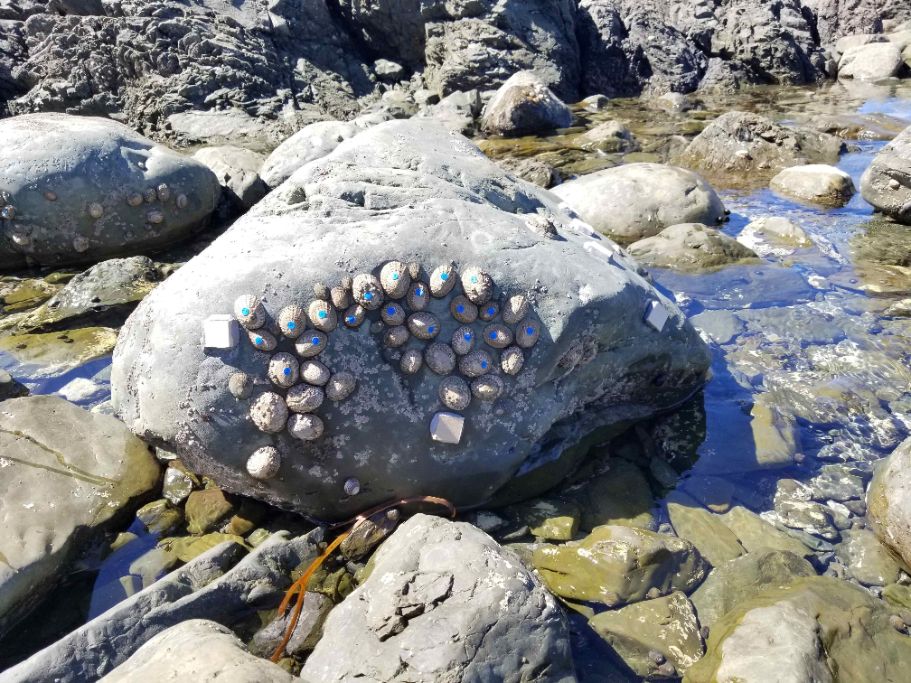
limpets avoiding the sun on a south-facing boulder
(Photo/Supplied)
Dr Spencer Virgin,
a post-doctoral fellow at Te Whare Wānanga o Waitaha |
University of Canterbury, has worked on a thesis project he
has dubbed ‘hot limpets’, exploring how these common
shellfish cope with a warming climate.
Dr Virgin found
that as temperatures rise, limpets move towards cooler,
south-facing rock surfaces to avoid overheating in the sun,
with some of them moving up to five metres as the crow flies
– up to 150 times their body length – to find
shade.
“This behaviour means they’re quite
resilient to the kind of extreme heat events that are
becoming more common,” Dr Virgin says. “The most
interesting thing to me, is that limpets are smarter than
people give them credit for.
“They know that when
temperatures start to rise in spring they need to go into
the shade and wait until it’s cool again before they can
come back out. As a result of this adaptive behaviour, I
think the long-term resilience of these species is quite
secure. It’s not all doom and gloom for limpets because
thankfully, they’re quite resilient and adaptive to heat
stress.”
Dr Virgin carried out this research in
Kaikōura, North Canterbury, and his first step was to find
out the thermal tolerances of limpet species living in the
area. To do this, he deployed ‘robo limpets’ – an empty
limpet shell filled with silicone gel and a tiny temperature
logger. He also built portable heart rate monitors for
limpets so that he could measure how heat stress affects
their heart rates.
Advertisement – scroll to continue reading
“I wanted to find out what
temperature is too hot for the suite of limpet species we
have in New Zealand, especially the four main ones in
Kaikōura. The second step was looking at how they respond
to that kind of heat stress in the field,” he
says.
Starting in 2022, he attached micro
tags to about 850 limpets around boulders in Kaikōura. He
visited these limpets every two weeks for one year to
measure what direction the limpets were facing to see if
they were moving in response to changing
temperatures.
Dr Virgin says limpets are
grazers so they play an important role in the healthy
functioning of marine ecosystems by maintaining bare space.
“They eat micro and macro algae, which form those slippery
biofilms that grow on rocks in the intertidal
zone.
“After the Kaikōura earthquake, for example,
there weren’t many grazers and pretty much the whole
coastline turned green because there was algae all along it.
But then when the limpets and other grazers came back, they
kept that algal growth down.”
Dr Virgin, who is
Canadian, says local limpets are “super cool”. “New
Zealand probably has more species of limpets than almost
anywhere else in the world – we’ve got a lot of big limpets
here. I think there are 15 or 20 species of limpets in New
Zealand including one exceptionally large egg-laying, air
breathing, limpet that’s common on the West
Coast.
“It’s amazing how resilient to heat stress
limpets are. Some of them don’t really show any effects of
heat stress until 38 or 39°C, so their thermal tolerances
are exceptionally high.”
He says they have another
quirky feature in that they are able to slowly
“bulldoze” other shellfish and barnacles out of their
path using their shell.
“If something settles too
close to a limpet, like a barnacle or something, they’ll
put the edge of their shell down and kind of bulldoze that
animal out of their way. To deal with this behaviour, small
limpets of some species will live on top of the bigger ones
so they don’t get bulldozed.”
Dr Virgin is
furthering his research under a Ministry of Business
Innovation and Employment-funded programme assessing
stressors to the marine ecosystem, led by UC Distinguished
Professor David Schiel and University of Waikato Professor
Chris Battershill. Dr Virgin is assessing differences
between North Island and South Island limpets in terms of
heat exposure and thermal tolerance. He is also
investigating why a cold-water limpet species that was
present in Kaikōura until the early 2000s is no longer
found anywhere north of
Oamaru.



 Coalition Govt ‘agrees to disagree’ over bill forcing tech giants to pay for news | Newshub
Coalition Govt ‘agrees to disagree’ over bill forcing tech giants to pay for news | Newshub